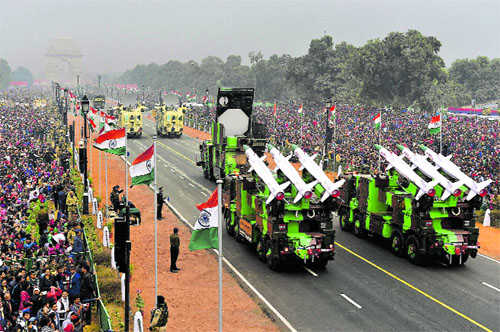
The Akash Missile system rolls down the Rajpath during the 68th R-Day Parade in New Delhi. PTI
Bhartendu Kumar Singh
EVERY year during the budget, many defence and strategic experts start clamouring for a higher budgetary allocation for the defence sector and this year was no different. The allocation of Rs 2.74 lakh crore (excluding defence pensions) is being perceived as “too less”. Seen from a layman's point of view, the defence budget is indeed appropriate since the growth rate is harmonious over the previous years' figures. The real challenge is to respond to the wider issues that prohibit the optimisation of the defence budget.
Indians have been debating the size of the defence budget for the past many years. Several recommendations by the Department-related Standing Committee of Parliament (DRSC) on defence has desired the defence budget to be at least 3 per cent of the GDP. While this was indeed the figures in the late 1980s, it is difficult to adhere to such high proportions due to contemporary developmental compulsions. The Thirteenth Finance Commission, however, took a pragmatic view and recommended a cap of 1.76 per cent of the GDP as defence budget since defence and development needed to go together.
The present defence budget is in harmony with the developmental compulsions of the country and the desirable linkage between security and development as identified by the Finance Commission. Little consideration is given to the fact security is something more than “mere defence of the borders”, and ought to give equal space to "left-over" aspects in the wider definition of security such as education, health, poverty eradication and infrastructure.
The duo of Amartya Sen and Jean Dreze have made notable contribution in the “development-as-security debate” but then they have remained marginalised in the security discourse. Little attempt has been made by mainstream strategic thinkers to link security with development. This, despite the fact the linkage has been successfully experimented with in our own neighbourhood (China) during 1979-1997, when there was a freeze on the defence budget. Perhaps this also explains why our strategic experts fail to appreciate quantum allocation for flagship projects like MNREGA or rural, agricultural and allied sectors that has seen budgetary allocation increased by a whopping 24 per cent. Clearly, they fail to see the logic that we need to spend more on rural areas, infrastructure and poverty alleviation.
While the Finance Ministry does judicious allocations of budget despite an acute competition for resources, it also encourages internal resource generation by other ministries. There lies a huge potential for the armed forces. The Chinese PLA, during much of 1980s and 1990s, made a successful killing through internal resource management and there is no reason why the same cannot be experimented in India without compromising combat capability. To give an example, the armed forces are sitting on huge number of marriage venues and shopping complexes but the rental income from these premises go to regimental funds. If these proceeds are deposited with the Government, some portion of the revenue expenditure can be taken care of.
The revenue expenditure itself can be brought down substantially so that money is available in the capital heads for funding of force modernisation. Unfortunately, the Shekatkar Committee, mandated with manpower reduction, diverted its major recommendation to peripheral issues. It is notable that India remains an exception in reducing manpower while undertaking a military modernisation drive. China made a notable reduction of its military manpower — from 4.9 million in the mid-1990s to 2.3 million at present. Another 3 lakh are going to be reduced by 2019, as part of China's recent military reforms announced last year. Indeed, a significant reduction in military manpower, along with extra civilian fat, is the need of the hour and there is a huge potential for doing that.
The diplomatic aspects of defence needs to be given due consideration. It is deft and mature defence diplomacy that has yielded dividends on the China front, with relative peace on the Line of Actual Control (LAC). India needs to perpetuate this relative peace with China for two to three decades. It cannot afford an arms race or a security dilemma with China. This is possible by expanding the present policy of network of relations with China as well as other countries in Asia-Pacific, establishing a healthy cooperative security framework in the region. This would enable India's policy makers to focus on building comprehensive national power without getting bogged down in a military showdown with China or Pakistan or a hypothetical combination of the two! Affordable defence is the call of the day. Many countries like the US and the UK have been living in the shadows of budgetary cuts and resource constraints and have been encouraged to resort to ways and means to optimise their defence budgets.
India is no exception and would continue to be challenged by developmental compulsions and resource constraints for the foreseeable future. There is, therefore, no escape for our armed forces from exploring the ways and means for affordable defence.
The writer is in the Indian Defence Accounts Service. The views expressed are strictly personal..



























